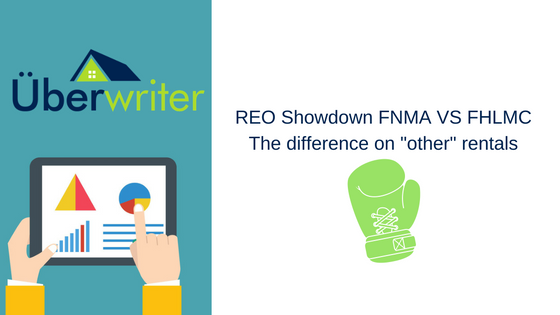I recently had a few discussions with some of our clients and blog followers about how different the REO calculations are between FNMA and FHLMC. Growing up in the business I was taught the FNMA method, and to be honest, I generally use the FNMA method since most of the time that number is more conservative (lower) than the FHLMC method.
But if you break down the more commonly used method in the mortgage business it would be following the FHLMC method. The reason for this is the FHLMC method is virtually identical to the method used by FHA guidelines (see 4000.1) when the FHA borrower has “other” properties generating rental income. In addition to FHA, most other government or state housing guidelines follow the FHLMC/FHA method since many of those programs use FHA as an example to build their underwriting guidelines. This gives the FHLMC method we are about to review the definite advantage as “most used” rental income calculation method.
The REO Showdown
But as I have said in many blogs, as underwriters we should never get comfortable with “close enough” or “this is what I have always done” we should be comfortable with doing the math as described by the investor, so let’s break down these differences.
This blog is only about the borrowers “other” REO found on the schedule E, excluding a multi-unit primary residence (FNMA only). If you are using the “lease” method FNMA/FHLMC treat “other” property pretty much identically. Ok, on to the math!!

Second here is the example PITI
$500 Principal and Interest
$200 Property Taxes
$100 Homeowners Insurance
$800 Total PITI
Now we can complete the math for both FNMA/FHLMC


FHLMC METHOD (TYPO CORRECTED FROM ORIGINAL POST!)
$9,500 Line 21 Final Income
Add back the following
$4,500 Line 18 Depreciation
$14,000 Total income
/12 months
$1,166.67 Monthly Income
Before we continue a note on the FHLMC income shown here, to streamline this blog only one year was analyzed but FHMLC requires a two-year average to be considered. The math is the same but after looking at the second year, the average used should be the lower of the 24-month average or the most recent 12 month average whichever is lower. On the flip side FNMA does not use the two year review method, they only require the most recent year be considered.
Final Results
$1,020.83 FNMA Rental Income
$1166.67 FHLMC Rental Income (typo corrected from original post)
As you can see the side by side comparison each method gives your two different numbers, this is why it is important to understand the rules at each agency (or what rules your investor/company follows). If you default to using the FNMA method, you will be “safe” but will probably decline borrowers for high ratios on borrowers when you could have approved them using the FHLMC method. If you default to using the FHLMC method, you will go over on ratios if your investor requires the FNMA method. This goes back to my opening statement, know your investors rules and how to properly apply the math.
Supporting Guidelines
FNMA B3-3.1-08: Rental Income (09/29/2015)
FHLMC 5306.1 Rental Income (03/02/2016)
FHLMC Form 91 supports the actual calculations noted in FHLMC 5306.1
So who is the winner between FNMA / FHLMC? I call this contest a “Draw”, there is no winner here. Bottom line is you must use the proper method that your investor follows or you risk having your quality rating taking a beating in the ring of underwriting.
Thanks for reading as always we invite you to check out IncomeXpert that can help you get this math right every time! IncomeXpert is the mortgage industries best online income calculator that will assist you in getting ANY borrowers income accurate to the penny.


4 Responses
Hey Michael you like st me in the FHLMC calculation when you went from $14,000 annual to $2291 monthly. I feel like as step is missing. Can you explain?
Hi Tim
The explanation was HUGE typo in my graphic!! Thank you for pointing that out, I corrected the blog to show the correct answer! The math should be $14,000 /12 – $1166.67 per month, which is what the blog shows now. Thank you so much for pointing that out! I need to make sure i slow down on my proof reading!
Thank you
Michael
Thank you for this post. I have a question, in the FHLMC method are you counting the rental payment against them in the liabilities and then giving them the income credit? Or do you just get to give them the amount of rental income and exclude the liability/mortgage if the property is not free and clear.
Hi Lindsey
The biggest difference between the two methods is not subtracting the PITI from the rental property. Most LOS will require you to create a work around in the system, what I mean is the mortgage payment (or just taxes/insurance if the home is F/C) should not be considered in the final DTI. Sorry I know what I am trying to say here but its hard to explain in words, but bottom line is you have to adjust your LOS until the answers equals the FHLMC method.
Thanks!